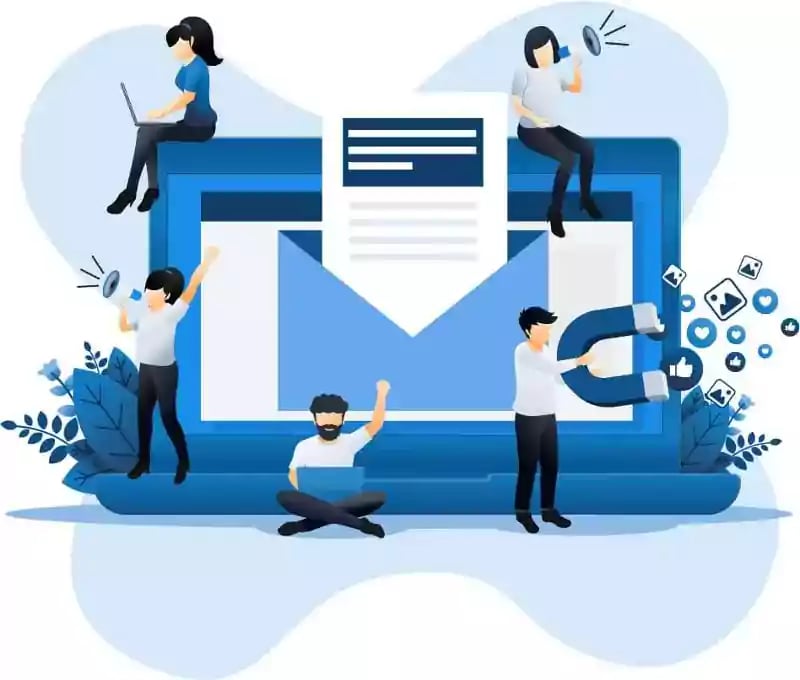How to Create an Email Marketing Plan That Works
Email marketing remains a powerful tool for businesses. And many companies recognize its potential for reaching and engaging their target audience. However, poorly executed email campaigns often lead to unsubscribes, spam flags, and regretful opt-ins.
We explore key elements of a successful email marketing plan, providing insights on how to create campaigns that resonate with subscribers and drive meaningful results.
Why Does Email Marketing Matter?
-
The average ROI of email marketing is 40. You can earn $40 in return for every dollar you spend on email marketing. This is a very high ROI compared to other marketing channels.
-
The average open rate for email marketing campaigns is around 20%. About one in five emails sent will be opened by the recipient. Consider targeting 22% using a solid subject line and relevant content.
-
The average click-through rate for email marketing campaigns is 2.4%. About one in 40 emails opened will be clicked on by the recipient. Consider improving it by using clear and concise call-to-actions and getting closer to 7.5%.
-
77% of B2B buyers prefer to be contacted over email. Email is one of the best ways to reach potential customers interested in your products or services. If you're not using email marketing, you're missing out on a huge opportunity to reach your target audience.
-
43% of marketers are changing how they measure email performance because of Apple's Mail Privacy Protection. This new feature makes it more difficult for marketers to track email opens and clicks, so adjusting your metrics is essential.
As a business, you mustn't accidentally push any target customers away because you didn't adequately plan your email marketing. Customizing your email campaigns correctly can be an effective way to acquire and retain customers.
Customers likely don't care about a message that blatantly promotes a product. But they will care if that message feels personal and brings them value. Here are some things to do to make your email marketing campaigns ones that enable your startup to succeed and grow.
Let's start with the best email construction specifics and then move to the broader plan for those emails. Savvy email marketers realize they must talk to their target customers individually. Here's how.
-
The "From" line shows that the sender is a real person: Don't write an email that looks like Spam. Make it personal. Having a name in the "from" field is the first step to doing just that. It puts a name on the content to follow.
-
The "Subject" line is specific: The context you build around your email ensures success or failure. The Subject should show your audience that their particular interests will be addressed. It should hint at a story and provoke curiosity.
-
Tell a story: Be entertaining and informative in telling a story in the email that addresses each individual in your target audience. This keeps them reading and coming back to read future emails.
-
Be hard to forget: Set up an automated series of emails to stay in touch consistently but not so frequently that you're annoying. If your unsubscribe rate is more than 10%, your message doesn't match your market, and if it's less, then maybe you're not edgy enough. Encourage those who purchase from you by sending emails showing how to use what they've just bought most effectively, highlighting any product's easy-to-miss features.
-
Stay relevant: Everyone you email expects it to be relevant to them. You will violate that expectation if you don't maintain different lists for different micro-segments by topic. Those people will no longer trust your emails, and you'll have lost them. Typical marketers treat everybody equally, but intelligent marketers know better and have a different list for each topic.
-
Be human: Express more of who you are in your emails. Show you're a real person, not just the company trying to sell a product. People will remember the human side and tell others about you. Show an instantly recognizable personality.
-
Use humor: As you're in the early stages of marketing your business, you may be nervous and apprehensive about your future success. It's okay to reflect some of that in your emails. It is better if you dial it up just a bit with humor; it makes you more human and, therefore, more believable, and that builds the trust you want to create in your readers. It's also been shown that humor aids in comprehension, so readers grasp your message more readily.
Let's look at broader ways to
Maximize Your Business's Email Efforts
Create buyer personas.
Buyer Personas are representations of your customers that you've based on actual customer data and market research. Put a name and a face on each micro-segment of your potential audience, and you can understand what a typical representative of that segment might be like. You can identify with that target customer's intent as they search for the products or services that best suit them. And you'll understand their point of view as they receive your emails so you can assess them from the target customers' perspective. As that customer, would this email be appealing? Or would you unsubscribe? What would make the email feel valuable to you? Using these personas helps you custom-craft your marketing messages for each defined segment of your target audience.
Do micro-segmenting.
Before actually sending out those marketing emails, take the time to research and analyze your target audience. Segmentation refers to dividing the pool of targets into different customer types based on their shared characteristics. Characteristics can be demographic, geographic, industries where they are employed, types of businesses they own, their profession, family status, leisure activities and interests, spending habits, or anything where the data is collectible.
Micro-segmentation is a more precise version that breaks down the segments into smaller, more specific pieces. Software programs like Optimove can use the information to sort customers into micro-segments. Once you have these smaller segments, you can craft emails customized for each customer type.
Brief content is best.
You will want to send emails with lists of offers, information, and advice. The best practice is to fight that tendency and keep your content brief and to the point. You want to offer value but not so much that the email is overwhelming. Offer the value upfront in a straightforward way. The most readable content is brief; regardless of how valuable particular content is, it doesn't mean anything if the customer doesn't read it.
Include extra value.
Everyone who put their name on your email list had a reason to do so. They believed being on that list would bring them value, consciously or unconsciously. You need to craft your emails to prove they were right.
Offer sign-up benefits like a limited-time discount or entry in a giveaway. Make the prize related to your product and something that should appeal to your target customers. Offer free advice like a valuable eBook or links to particularly relevant blog posts. Your goal is to make your target audience feel they've gained something after reading your email.
In conclusion, creating a user-friendly email might be challenging but very worth it!
It is not easy to create those emails that keep customers opening and reading them. It remains the most direct way to reach potential customers and is effective...if you do it right. It takes time and effort. But this is doable for even the smallest startup.
Divide your target audience into the most precise segments possible and write brief customized emails with each of these groups in mind. Offer them genuine value in each email. As you keep them reading, you'll acquire new customers and continue strengthening your initial loyal base so your startup will succeed long-term.
This content is also available in:
- German: Wie man einen funktionierenden E-Mail-Marketingplan erstellt
- Spanish: Cómo crear un plan de marketing por correo electrónico que funcione
- French: Créer un plan de marketing e-mail efficace
- Italian: Come creare un piano di email marketing che funzioni
- Romanian: Cum să creați un plan de marketing prin e-mail care să funcționeze
- Chinese: 如何制定行之有效的电子邮件营销计划











Leave a Comment